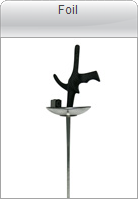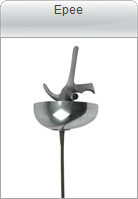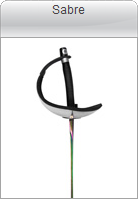Basic Information
The general goal of a fencing match (called a bout) is to cause your blade to come into contact with a valid target area (called a touch) on your opponent while simultaneously preventing them from doing the same to you. When a touch is scored, a light indicating who touched whom lights up and the presider (referee) incidates which fencer is awarded the point based on the current weapon being fenced.
The weapons – the foil, the epee and the sabre – belong to an earlier era, as do the notions of honour and chivalry that form the basis of many of the sport’s rules. But the uniforms, with their electronic sensors, impregnable masks, and the electronic scoring system are very much a part of today’s high-tech world
 The foil is light and flexible, originally developed in the mid-17th century as a training weapon for the Pariser small sword, a light one-handed sword designed almost exclusively for thrusting
The foil is light and flexible, originally developed in the mid-17th century as a training weapon for the Pariser small sword, a light one-handed sword designed almost exclusively for thrusting
 The modern sporting Épée was invented in the second half of the 19th century by a group of French students, who felt that the conventions of foil were too restrictive, and the weapon itself too light; they wanted an experience closer to that of an actual duel. The concept was to create an exact copy of a small sword but without the needle-sharp point. Instead, the blade terminated in a point d’arrêt, a three-pronged tip which would snag on the clothing without penetrating the flesh.
The modern sporting Épée was invented in the second half of the 19th century by a group of French students, who felt that the conventions of foil were too restrictive, and the weapon itself too light; they wanted an experience closer to that of an actual duel. The concept was to create an exact copy of a small sword but without the needle-sharp point. Instead, the blade terminated in a point d’arrêt, a three-pronged tip which would snag on the clothing without penetrating the flesh.
 Sabre is the ‘cutting’ weapon: points may be scored with edges and sides of the blade, as well as the point. Although the modern design with a light and flexible blade (marginally stiffer than a foil blade which bends easily up and down while a sabre blade bends easier side to side) appeared around the turn of the 19th and 20th century, similar sporting weapons with more substantial blades had been used throughout the Victorian era.
Sabre is the ‘cutting’ weapon: points may be scored with edges and sides of the blade, as well as the point. Although the modern design with a light and flexible blade (marginally stiffer than a foil blade which bends easily up and down while a sabre blade bends easier side to side) appeared around the turn of the 19th and 20th century, similar sporting weapons with more substantial blades had been used throughout the Victorian era.
Rules & Regulations
Given the highly technical nature of the sport of fencing and the evolution of the sport from its roots teaching young men how to survive a duel, it is inevitable that the rules governing fencing in competition are equally as confusing and technical as the sport’s origins. However, the basics of the sport can be distilled into a few simple points to keep in mind.
1. A fencer may only engage in contest with properly approved and inspected equipment.
2. Fencing does not begin until the referee says so.
3. A fencer must stay within the edges of the piste.
4. A touch may only be made with a valid part of the blade.
5. The weapon must be held in the hand at the time of the touch and at all times during the match.
6. Only the weapon may be used to stop an oncoming attack.
7. The referee is the final arbiter of any dispute.
8. Respect shall be shown to all opponents, referee’s, coaches and bystanders.
9. Excessive brutality, violence, cheating, drugs, etc… are ABSOLUTELY FORBIDDEN.